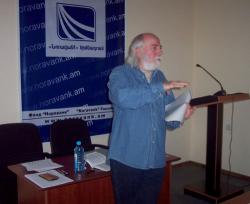NORAVANK LECTURING LEVON ABRAHAMYAN: “ARMENIAN AZG: NATION-STATE OR FAMILY-STATE?”
 On November 7 in “Noravank” Foundation was delivered a lecture on the subject “Armenian Azg: nation state or family state?” (lectured by Levon Abrahamian: the ethnographer, head of the department of contemporary anthropological studies, Institute of Archeology & Ethnography, National Academy of Sciences of Armenia) in accordance with the “Noaravank” educational program on “Armenia and the Armenians in global developments: the present situation and challenges.”
On November 7 in “Noravank” Foundation was delivered a lecture on the subject “Armenian Azg: nation state or family state?” (lectured by Levon Abrahamian: the ethnographer, head of the department of contemporary anthropological studies, Institute of Archeology & Ethnography, National Academy of Sciences of Armenia) in accordance with the “Noaravank” educational program on “Armenia and the Armenians in global developments: the present situation and challenges.”
When in the 19th century in Europe appeared the conceptions nation and nationalism in the same meaning as today, the Armenians made an attempt to express that new conception with an appropriate word according to the “translating” model of their language. The preference was quite naturally given to the word azg, as it includes the meanings “tribe,” “dynasty,” “nation,” “order,” “class” like the Latin word nation. However, accepting that new meaning, the Armenian word azg, in comparison with the non-translated foreign word nation, doesn’t lose its general “tribal” meaning. Let’s remember, for example, the widely used word azganun (surname), which lacks the shade of abstract meaning and, on the contrary, it seams that it takes the conception azg/nation back to the tribal reality.
Although the word azg doesn’t have the direct meaning of “family” (in Armenian this meaning is better express by the word gerdastan (dynasty)), however, it is attached to the semantic field of “big family.” It is not by chance that today in the streets of Yerevan young people address the people of the same age with the words “aper” (“yeghbayr” (brother)) or “quyrik” (sister) and they usually address the representative of older generation with the words “hopar” (uncle) or “morqur” (aunt), and senior female citizens - “mayrik” (mother). The addressing “hayrik” (father) is used more seldom, but if used, than in the circle of people using the above mentioned adressings “aper” and “hopar.” The younger ones address the older generation calling them “tati/papi” (granny, grandpa) like the Russian do. That’s to say, the whole Armenian society – nation, is modeled in the form of family: children, parents – mother, father, and sisters/brothers of the latter ones. The context of a “big family” of azg, lacking in the word nation and all the conceptions originating from it, can not but transmit some shades of family to azg/nation and to suchlike typical Armenian conceptions. So, the clan system in Armenia includes all the structures beginning with the very family and work collectives to the supreme authority. Today the traditional family/clan orientations in the village hinder the experimental programs implemented by international organizations, which are based on community principles. In our days many international organization show more qualities of family organizations. Even the terrorist group, which shot dead the deputies of the National Assembly on October 27, 1999, had a well expressed family/clan character. Let’s mention that so often expressed individualism among Armenians also includes the family: usually the individual appears together with his family, although the later one is not revealed outwardly: that’s to say, in reality, the individualism of Armenians is a unique “family worship.”
Comparing mainly the ethnographic materials, the speaker came to the conclusion that the same conception which today is considered in the discourse of “nation-state,” is expressed as “family-nation” in case of Armenia.
In up-to-date discourse azg has been known as “nation” since 18-19 centuries, in some cases asserted in the 20th century. There are a few theories on this issue, including the Andersonyan one, according to which in 18-19 centuries a group of people acquired very distinctive qualities, thanks to which it turnd into a nation. From the other hand, the processes of nation formation are closely connected with national awakening. In case of Armenians, the situation seems to be different. L. Abrahamyan puts forward the thesis that the Armenians were formed as a “nation” (with the characteristic traits of 18-19 centuries) still in the 5th century. He attracted special attention to the most important characteristic traits of that issue a) general history, which was shared by the people of that time and which was continuously inherited to the society, perhaps through preaches, b) general language c) state religion.
At the discussion following the lecture, which lasted for about an hour and a half, were more thoroughly discussed the questions relating to the topic of lecturing.


